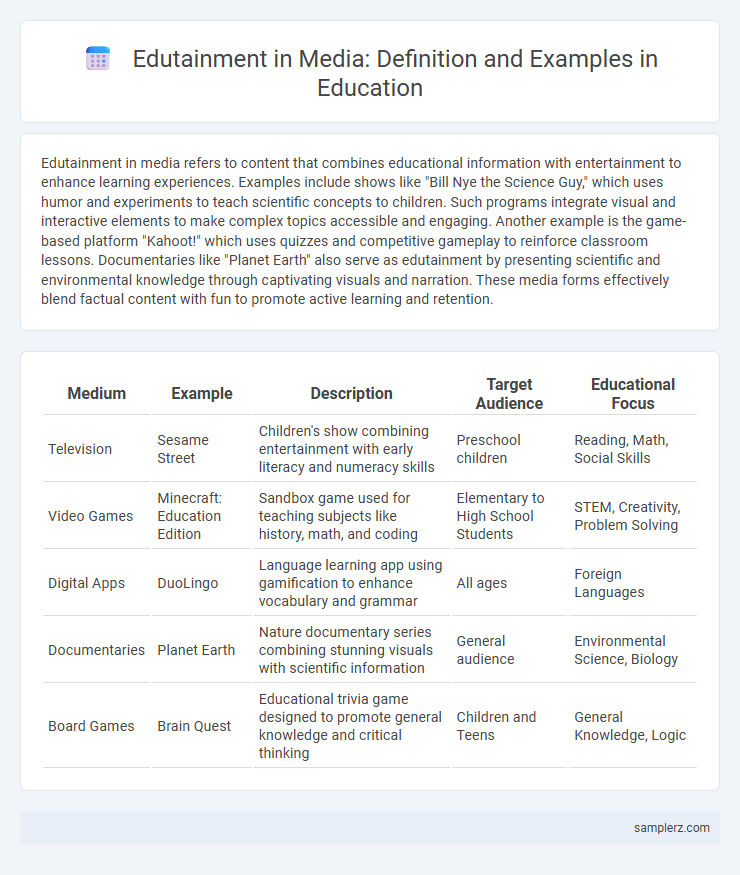Edutainment in media refers to content that combines educational information with entertainment to enhance learning experiences. Examples include shows like "Bill Nye the Science Guy," which uses humor and experiments to teach scientific concepts to children. Such programs integrate visual and interactive elements to make complex topics accessible and engaging. Another example is the game-based platform "Kahoot!" which uses quizzes and competitive gameplay to reinforce classroom lessons. Documentaries like "Planet Earth" also serve as edutainment by presenting scientific and environmental knowledge through captivating visuals and narration. These media forms effectively blend factual content with fun to promote active learning and retention.
Table of Comparison
| Medium | Example | Description | Target Audience | Educational Focus |
|---|---|---|---|---|
| Television | Sesame Street | Children's show combining entertainment with early literacy and numeracy skills | Preschool children | Reading, Math, Social Skills |
| Video Games | Minecraft: Education Edition | Sandbox game used for teaching subjects like history, math, and coding | Elementary to High School Students | STEM, Creativity, Problem Solving |
| Digital Apps | DuoLingo | Language learning app using gamification to enhance vocabulary and grammar | All ages | Foreign Languages |
| Documentaries | Planet Earth | Nature documentary series combining stunning visuals with scientific information | General audience | Environmental Science, Biology |
| Board Games | Brain Quest | Educational trivia game designed to promote general knowledge and critical thinking | Children and Teens | General Knowledge, Logic |
Interactive TV Shows Blending Learning and Fun
Interactive TV shows like "Brain Candy Live!" and "Dora the Explorer" effectively blend learning and fun by engaging children in problem-solving and language skills through on-screen activities. These programs incorporate real-time audience participation and gamified elements to enhance retention and motivation. Research shows that interactive media significantly improves cognitive development and knowledge application in young viewers.
Educational Video Games Engaging Young Minds
Educational video games combine interactive gameplay with curriculum-based content to enhance learning retention in subjects like math, science, and history. Titles such as "Minecraft: Education Edition" and "Osmo" use immersive environments and problem-solving challenges to develop critical thinking and creativity among children. Research shows these games improve engagement and motivation, making complex topics accessible and enjoyable for young learners.
Animated Series Teaching Science Concepts
Animated series like "Magic School Bus" effectively blend entertainment with education by illustrating complex science concepts such as ecosystems, the solar system, and human biology through engaging storytelling and vivid visuals. These shows use relatable characters and narrative-driven lessons to enhance comprehension and retention of scientific principles in children. Incorporating interactive elements and real-world applications in episodes fosters curiosity and promotes active learning in young audiences.
Documentary Films Promoting Social Awareness
Documentary films like "An Inconvenient Truth" and "13th" effectively blend education and entertainment by raising social awareness on climate change and racial injustice. These films use compelling storytelling, expert interviews, and impactful visuals to engage audiences while delivering crucial information. Their widespread distribution on platforms such as Netflix and PBS maximizes reach, encouraging public discourse and social change.
Podcasts Making Learning Entertaining
Podcasts such as "Stuff You Should Know" and "Brains On!" blend education with entertainment by delivering engaging, well-researched content on diverse topics, appealing to a broad audience while enhancing knowledge retention. These podcasts utilize storytelling, expert interviews, and sound effects to create immersive learning experiences that capture listener interest and foster curiosity. By combining accessible language with high-quality production, educational podcasts transform traditional learning into an enjoyable and dynamic activity.
Virtual Reality Experiences for Immersive Education
Virtual reality experiences in education create highly immersive learning environments that enhance student engagement and retention. Platforms like Google Expeditions and Oculus Education offer interactive simulations ranging from historical events to complex scientific phenomena, allowing learners to explore concepts firsthand. These VR tools blend entertainment with education, making abstract subjects more tangible and fostering deeper understanding through experiential learning.
YouTube Channels Revolutionizing Home Learning
YouTube channels like CrashCourse, Khan Academy, and TED-Ed are revolutionizing home learning by combining entertainment with educational content. These platforms use engaging visuals, concise explanations, and interactive quizzes to enhance student understanding across subjects such as science, history, and mathematics. Millions of learners benefit daily from their accessible, high-quality videos that promote self-paced, multimedia learning experiences.
Storytelling Apps for Literacy Development
Storytelling apps like "Epic!" and "Tales2Go" enhance literacy by combining engaging narratives with interactive features that improve reading comprehension and vocabulary skills. These platforms use multimedia elements such as audio narration, animations, and gamified quizzes to maintain learner interest and support diverse learning styles. Research indicates that children using storytelling apps demonstrate higher motivation and improved literacy outcomes compared to traditional reading methods.
Music-Based Media Enhancing Memory Retention
Music-based media such as educational songs and rhythm-driven podcasts enhance memory retention by engaging multiple cognitive pathways in the brain. Studies show that melodies and repetitive lyrics improve recall by linking information to auditory cues, making learning more effective and enjoyable. Platforms like "Schoolhouse Rock!" and interactive music apps demonstrate how synchronized music and learning content boost long-term retention in students.
Mobile Learning Platforms with Gamified Features
Mobile learning platforms like Duolingo and Kahoot! exemplify edutainment by integrating gamified features such as points, leaderboards, and interactive quizzes that enhance student engagement and retention. These platforms use adaptive learning algorithms to personalize content, optimizing educational outcomes through real-time feedback and progress tracking. Gamification elements motivate learners by turning educational content into rewarding challenges, making complex subjects more accessible and enjoyable on-the-go.

example of Edutainment in media Infographic
 samplerz.com
samplerz.com